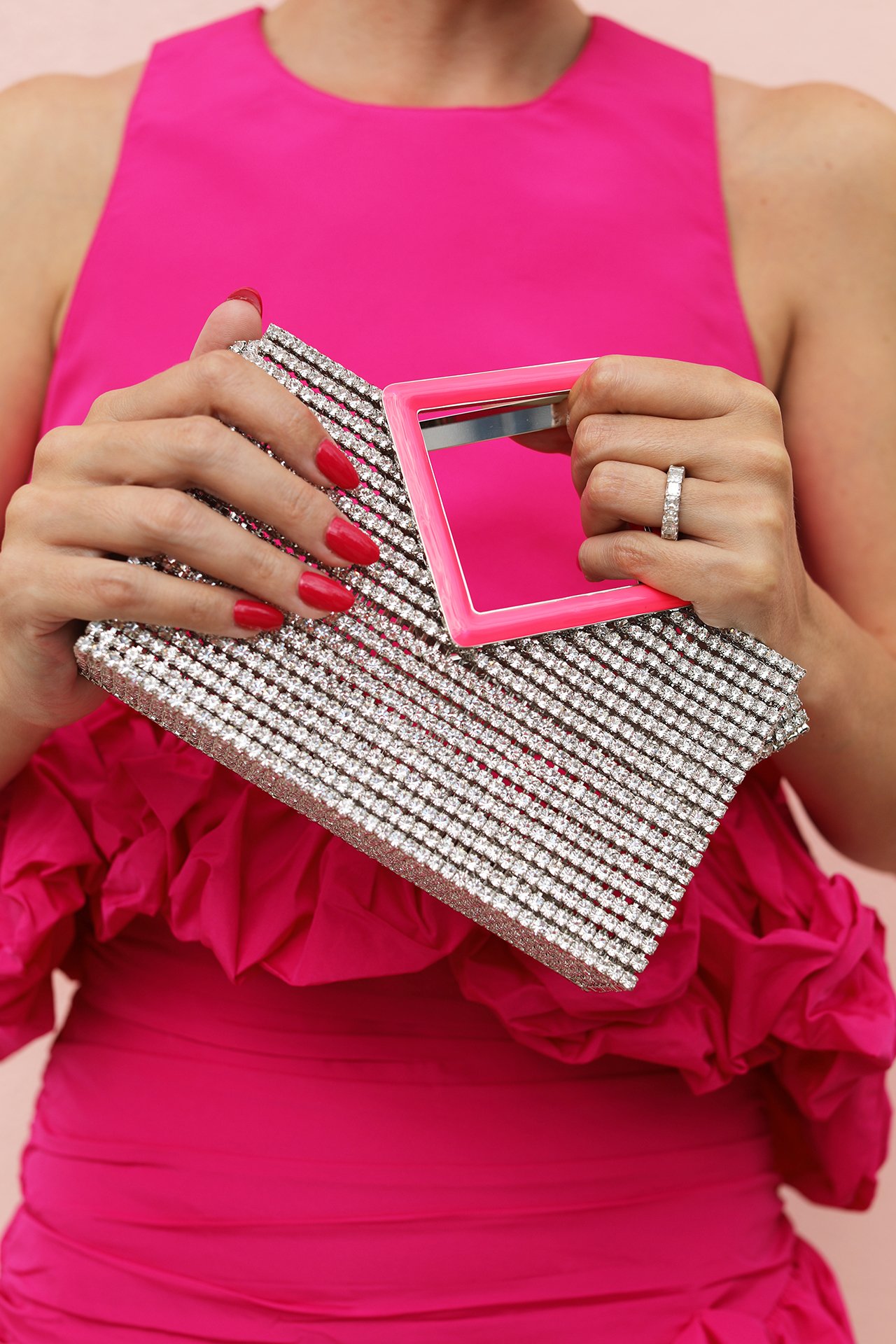
Christian Lacroix’s Latest Fashion Move Is Virtual – WWD
[ad_1]
Three and a half decades ago, the house of Christian Lacroix lit up the fashion world and cemented “le pouf” skirts as the official look of the late ’80s and early ’90s. The brand primarily moved on from the runways in the years since and into new territory like furniture, gifts and home textiles. But it never forgot its fashion DNA.
Now the company is celebrating 35 years in business by venturing out yet again, this time in the virtual space, and it brought plenty of nostalgia in digital form.
On Tuesday the metaverse, specifically Decentraland, was the venue for the company’s anniversary party, an event replete with 3D and digital versions of some of the design house’s best-known looks.
Through a partnership with the NFT platform Exclusible, Christian Lacroix went into the archives to conjure 2002’s red bride, as famously worn by Madonna, and the 2008 couture wedding dress made famous by Lady Gaga in her 2011 “Judas” music video. (Apparently, the singer, songwriter and actress is still a fan of the designer’s bridal couture. Just last week, two Lacroix wedding gowns made cameos at the opening of her Chromatica Ball world tour in Düsseldorf, Germany.)
Everyone who attended the virtual party received their own wearable, a custom digital T-shirt. But another premium perk awaited other VIP guests: a complete digital suit featuring Lacroix’s signature Paseo pattern.
The nature of those VIPs matter, because these guests were invited via NFT.

The Lacroix couture gowns worn by Madonna (left) and Lady Gaga (right) were on display at the brand’s anniversary party in Decentraland.
Courtesy image

Christian Lacroix’s Paseo suit, which was given to owners of its premiere NFT collection at its anniversary party in Decentraland.
Courtesy image
Turns out, the Decentraland party and digital wearables are only a piece of a larger metaversal strategy by house Lacroix. It got underway last month when the company signed a virtual lease with Exclusible for a new luxury penthouse in the virtual world. Stage two followed shortly after with the release of the brand’s very first NFTs on OpenSea. The “Rêves de Soie” collection, which translates to “silk dreams,” was based on the brand’s handcrafted “Carrés” scarves. Sets of 350 designs were on offer for a total inventory of 700 NFTs.
Stage three was the anniversary event and wearables. But it doesn’t stop there. According to the company, these projects fit into a broader initiative to usher Lacroix into Web 3.0, with each phase touting unique aspects.
The digital scarves, for instance, were made available early on a pre-paid basis. That’s unusual for NFTs. Typically early interest amounts to pre-registrations or perhaps early alerts for drops, but aren’t transactional. Another twist lies in the fundamental tech: Rêves de Soie NFTs are backed by “generative” music.
The term refers to the way it was created. Using one original work, a system or algorithm can generate numerous variations, resulting in multiple, unique new NFTs. That matters for the creators who mint them, but for buyers, it’s an aspect that adds rarity to the item. Right now the music industry is figuring out the best way to use generative songs, but in general it’s rather uncommon to find them integrated into visual NFTs.
Whether consumers picked up on that is an open question. But Rêves de Soie owners surely noticed something else: Their new digital scarves come with a real-world counterpart.
“There’s a window for people that are holding the NFT that points to the end of July through the first weeks of August, where they can redeem it to get the physical piece,” Nicolas Topiol, chief executive officer of Christian Lacroix, told WWD. “They get the NFT and the scarf, and this is the way we feel we can connect the two worlds.” The physical products feature the sort of rich, artistic prints that the brand is known for, produced by the company’s longtime partner in Como, Italy, a region famous for its silk production.
And, of course, those NFT owners were automatically invited to the Decentraland party and received Lacroix’s digital Paseo suits.
Brands have only begun to explore all the different ways NFTs can unlock experiences, both in the real world and the virtual one. But platforms like Exclusible aim to shine a light on what’s possible. Its luxurious, virtual penthouses, for example, were made available via NFTs.
According to Topiol, the virtual environment will act as a functional meeting place, event venue and showroom for Lacroix home goods, prints and textiles.
“Because our prints are working in home and lifestyle, we were dressing the penthouse to be our own,” he added. “We’ll also be using it as part of the utilities for the NFT drop, where we will be holding a workshop for NFT holders in the next six to 12 months.” Even the view out of the windows is on brand, with an Eiffel Tower in the distance.

One of Exclusible’s luxury virtual penthouses. Christian Lacroix was among the first major brands to sign up.
Courtesy image
As a long-term tech partner, Exclusible drives much of this initiative through each stage, from the penthouse and NFT pre-payments, to the anniversary party and more.
“Collectors are curious, but they don’t have a lot of knowledge about brands in general or luxury brands,” explained Olivier Moingeon, cofounder and chief commercial officer at Exclusible. “So it’s a new way to do brand discovery, and we start from a point of view that they understand.”
Moingeon may be the ideal partner for Lacroix. Nearly two decades of experience in luxury — at places such as Cartier, Goyard and Bastide — inform his perspective, and it was this blend of luxury and tech that resonated for Topiol.
“He understands our codes, where we come from,” the Lacroix CEO said. The conversations began late last year, “around the time when Dolce & Gabbana did their drop. It was quite substantial. I think, in our world of fashion brands going into Web 3.0, it was probably the most impactful one, financially, by far.”
Not that Lacroix’s own metaverse debut would be about making a quick buck. Topiol stressed that it wasn’t a financial decision. It was about learning this new environment, how to express the brand within it and appeal to a new audience who may not know who or what Christian Lacroix is.
There are still plenty of people who do remember, though. In fact, the brand’s backstory has become the stuff of legend, a notable chapter in the annals of fashion history.
The story of Christian Lacroix, as a business, is either a tragedy or a triumph depending on the lens. The designer’s creative genius didn’t equate to profitability, leading to losses of some 150 million euros (nearly $152 million in U.S. dollars) over 22 years. The company was backed by LVMH Moët Hennessy Louis Vuitton then, but ultimately sold to the Falic Fashion Group in 2005. Under new ownership, Topiol steered the business away from couture, pivoting to licensing, home goods and gifts. The only fashion ties that remained were in menswear and accessories.
It may be a cautionary tale for the fashion set, a warning that even brilliant talent can’t survive without business acumen. But to others, Topiol pulled off a miracle. He’s spoken at business conferences about what it took to bring the house back from the brink and turn it into a profitable operation, primarily crediting its approach to partnerships and licensing.
The metaverse is poised to be the next chapter in the brand’s story. The tech, channeled by its latest partner, allows the business to hark back to its fashion past while carving out its future. The timing may be apt as well, given what looks like a resurgence of Lacroix appreciation. One might imagine some furious Googling by Gen Z consumers when Kirsten Dunst wore a red, vintage Lacroix gown at the Oscars in March, or when Gaga offered her latest ode to the designer in Germany.

Kirsten Dunst, decked out in vintage Lacroix, and Jesse Plemons at the 94th Academy Awards held at Dolby Theatre at the Hollywood & Highland Center on March 27, 2022, in Los Angeles.
Lexie Moreland/WWD
It also helps that, over the years, both the founding designer and the brand have kept the name alive in fashion circles.
Lacroix, the man, found a home in stage costuming, but continues to work with longtime partner Desigual and other projects, such as the high-profile Dries Van Noten collaboration for spring 2019. He also pops up in the media to talk about the state of couture.
Meanwhile house Lacroix, a company that loves partnerships, racked up a number of its own — mainly with newer, trendier brands such as Uooyaa, Anaïs Jourden, Rixo, Swiminista and Ultracor. Whether those collabs actually herald the house’s earnest return to fashion remains to be seen. But the strongest indication came from Topiol himself.
A few years ago, he told WWD that he was interested in a fashion comeback, at least for women’s contemporary. In fact, it’s the reason it pursued that spate of collaborations.
That was a different world, though, in those days before the pandemic. Plans from 2019 don’t fit neatly into a 2022 business. Back then, few had even heard of the word “metaverse,” but it’s all brands and tech makers can talk about today.
The time could be ripe for Lacroix to pull all of it together — its celebrated past in couture, its hopes for a new fashion future and a tech movement obsessed with literal world-building for gamers, shoppers and brands. The company’s nascent digital fashion wearables suggest this could be an interesting path forward.
One thing is certain: The theatrical, even fantastical, sensibility that put Lacroix on the map, for both the designer and the early brand, would be right at home in a virtual world where anything is possible.
[ad_2]
Source link


